Linking mechanisms in data repositories: A case study of BioSample database (2020)
This poster reports upon a case study of the linking mechanisms in the NCBI BioSample database and its immediate connections, examining the types of links, their functions, and implications according to the FAIR data principles. The study allowed the authors to conduct a more detailed analysis of one area of data management by focusing on one database’s linking mechanisms, providing a glimpse into the role of linking mechanisms to support biomedical research and discovery and serving as a model for future studies.
Within research data repositories, metadata plays a critical role in enabling discovery, tracking, verification, quality control, and the use and reuse of data. These functions are well defined by the findability, accessibility, interoperability, and reusability (FAIR) principles (Wilkinson et al., 2016). Creating data in alignment with the FAIR principles in the vastly complex research data landscape requires not only carefully designed metadata schemas but also linking mechanisms across repositories and systems, allowing metadata to assist with managing and curating this information and to enable simultaneous search and retrieval across multiple data repositories.
VIEW PUBLICATION >>>
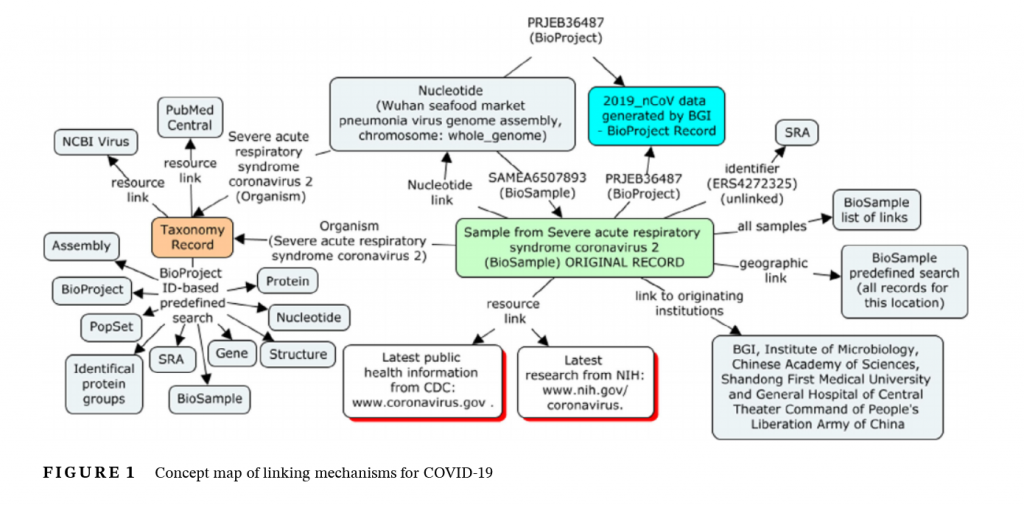
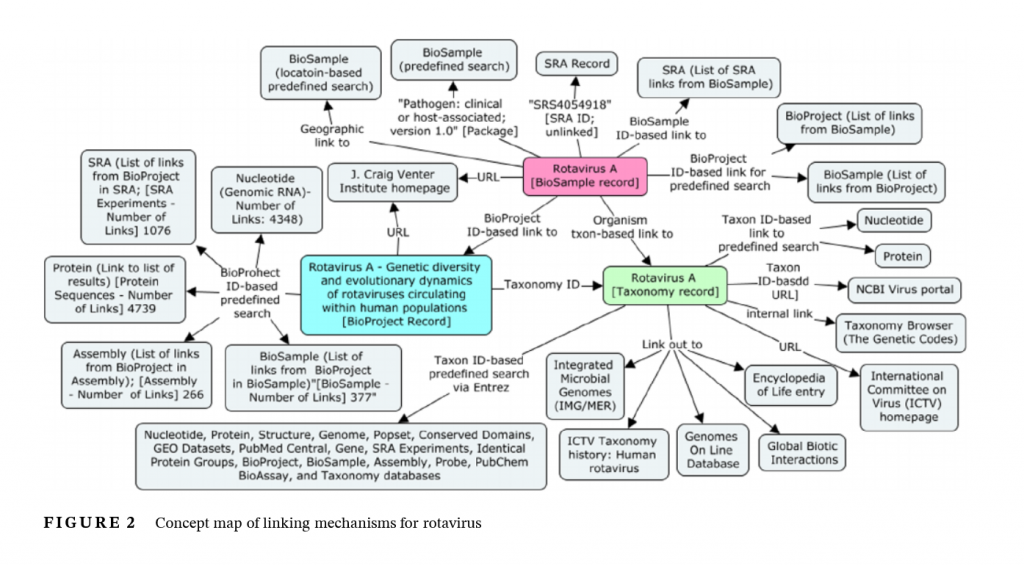
- Qin, J., A. Leathers, & V. Tompkins. (2020). Linking Mechanisms in Data Repositories: A Case Study of BioSample Database. In: Proc. Assoc. Info. Sci. Tech. https://doi-org.libezproxy2.syr.edu/10.1002/pra2.365
Remodeling Archival Metadata Descriptions for Linked Archives (2019)
Though archival resources may be valued for their uniqueness, they do not exist in isolation from each other, and stand to benefit from linked data treatments capable of exposing them to a wider network of resources and potential users. To leverage these benefits, existing, item-level metadata depicting physical materials and their digitized surrogates must be remodeled as linked data. A number of solutions exist, but many current models in this domain are complex and may not capture all relevant aspects of larger, heterogeneous collections of media materials.
This paper presents the development of the Linked Archives model, a linked data approach to making item-level metadata available for archival collections of media materials, including photographs, sound recordings, and video recordings. Developed and refined through an examination of existing collection and item metadata alongside comparisons to established domain ontologies and vocabularies, this model takes a modular approach to remodeling archival data as linked data. Current efforts focused on a simplified, user discovery focused module intended to improve access to these materials and the incorporation of their metadata into the wider web of data. This project contributes to work exploring the representation of the range of archival and special collections and how these materials may be addressed via linked data models.
VIEW PUBLICATION >>>
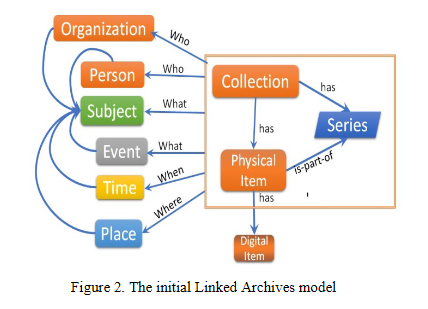
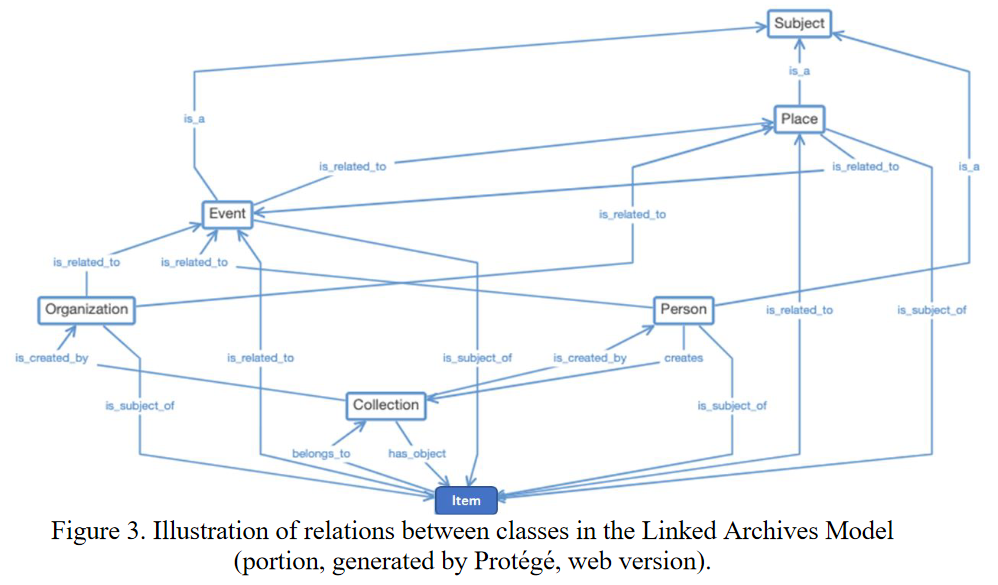

- Dobreski, B., J. Park, A. Leathers, & J. Qin. (2019). Remodeling Archival Metadata Descriptions for Linked Archives. In: The Dublin Core International Conference DC-2019. https://dcpapers.dublincore.org/pubs/article/view/4025/2227
Modeling Domain Metadata beyond Metadata Standards (2016)
The Laser Interferometer Gravitational–wave Observatory (LIGO) project to detect gravitational waves represents a complex, distributed scientific endeavor posing specific challenges for reproducibility and data management. The integration of provenance and other metadata information into the workflow stands as one means of addressing such challenges.
The goal of a metadata model for the LIGO workflow is the provision of metadata describing all the data products at each significant milestone in the data analysis pipeline. Given both the highly specific domain and the need to support current analysis tools, the development of such a model demands a more complex, comprehensive approach. For this reason, we pursued a multi-pronged approach to metadata modeling, gathering users’ conceptions, system information, research artifacts, and other organizational documents, and worked to combine the findings into one final model. This approach provided a thorough understanding of the overall research lifecycle and insight into scientific workflow metadata modeling.
VIEW PUBLICATION >>>
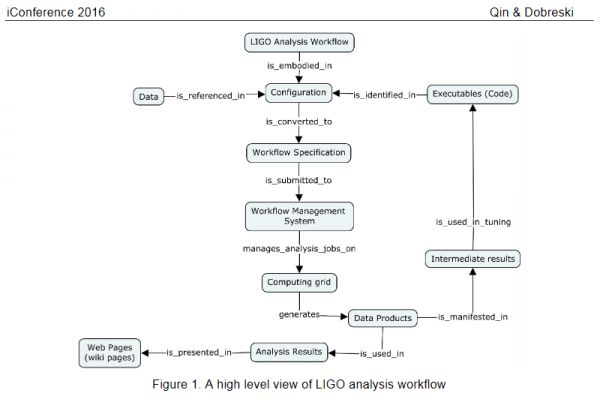
- Qin, J. & Dobreski, B. (2016). Modeling domain metadata beyond metadata standards. iConference, Philadelphia, PA, March 2016. http://hdl.handle.net/2142/89400
- Qin, J., A. Leathers, & V. Tompkins. (2020). Linking Mechanisms in Data Repositories: A Case Study of BioSample Database. In: Proc. Assoc. Info. Sci. Tech. https://doi-org.libezproxy2.syr.edu/10.1002/pra2.365.
VIEW PUBLICATION >>>
- Dobreski, B., J. Park, A. Leathers, & J. Qin. (2019). Remodeling Archival Metadata Descriptions for Linked Archives. In: The Dublin Core International Conference DC-2019. https://dcpapers.dublincore.org/pubs/article/view/4025/2227
VIEW PUBLICATION >>>
- Qin, J. & Dobreski, B. (2016). Modeling domain metadata beyond metadata standards. iConference, Philadelphia, PA, March 2016. http://hdl.handle.net/2142/89400
VIEW PUBLICATION >>>
- Liu, X. & Qin, J. (2014). An interactive metadata model for structural, descriptive, and referential representation of scholarly output. Journal of the American Society for Information Science and Technology, 65(5): 964-983. https://doi-org.libezproxy2.syr.edu/10.1002/asi.23007
VIEW PUBLICATION >>>
- Liu, X., Chen, M., & Qin, J. (2014). Interlinking cross language metadata using Heterogeneous graphs and Wikipedia. Dublin Core International Conference DC-2014, Austin, TX, October 8-10, 2014.
VIEW PUBLICATION >>>
- Qin, J. & Li, K. (2013). How portable are the metadata standards for scientific data? A proposal for a metadata infrastructure. In: Dublin Core International Conference DC-2013, Lisbon, Portugal, September 2-6, 2013.
VIEW PUBLICATION >>>
- Qin, J., Ball, A., & Greenberg, J. (2012). Functional and architectural requirements for metadata: Supporting discovery and management of scientific data. Dublin Core International Conference DC-2012, Kuching, Malaysia, September 3-7, 2012.
VIEW PUBLICATION >>>





